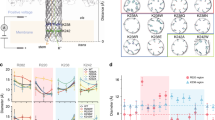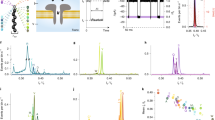Abstract
Protein nanopores offer an inexpensive, label-free method of analysing single oligonucleotides. The sensitivity of the approach is largely determined by the characteristics of the pore-forming protein employed, and typically relies on nanopores that have been chemically modified or incorporate molecular motors. Effective, high-resolution discrimination of oligonucleotides using wild-type biological nanopores remains difficult to achieve. Here, we show that a wild-type aerolysin nanopore can resolve individual short oligonucleotides that are 2 to 10 bases long. The sensing capabilities are attributed to the geometry of aerolysin and the electrostatic interactions between the nanopore and the oligonucleotides. We also show that the wild-type aerolysin nanopores can distinguish individual oligonucleotides from mixtures and can monitor the stepwise cleavage of oligonucleotides by exonuclease I.
This is a preview of subscription content, access via your institution
Access options
Subscribe to this journal
Receive 12 print issues and online access
$259.00 per year
only $21.58 per issue
Buy this article
- Purchase on Springer Link
- Instant access to full article PDF
Prices may be subject to local taxes which are calculated during checkout




Similar content being viewed by others
References
Kasianowicz, J., Brandin, E., Branton, D. & Deamer, D. Characterization of individual polynucleotide molecules using a membrane channel. Proc. Natl Acad. Sci. USA 93, 13770–13773 (1996).
Reiner, J. E. et al. Disease detection and management via single nanopore-based sensors. Chem. Rev. 112, 6431–6451 (2012).
Cherf, G. M. et al. Automated forward and reverse ratcheting of DNA in a nanopore at 5-A precision. Nature Biotechnol. 30, 344–348 (2012).
Laszlo, A. H. et al. Decoding long nanopore sequencing reads of natural DNA. Nature Biotechnol. 32, 829–833 (2014).
Wendell, D. et al. Translocation of double-stranded DNA through membrane-adapted phi29 motor protein nanopores. Nature Nanotech. 4, 765–772 (2009).
Haque, F. et al. Single pore translocation of folded, double-stranded, and tetra-stranded DNA through channel of bacteriophage phi29 DNA packaging motor. Biomaterials 53, 744–752 (2015).
Franceschini, L., Soskine, M., Biesemans, A. & Maglia, G. A nanopore machine promotes the vectorial transport of DNA across membranes. Nature Commun. 4, 2415 (2013).
Ying, Y. L., Zhang, J. J, Gao, R. & Long, Y. T. Nanopore-based sequencing and detection of nucleic acids. Angew. Chem. Int. Ed. 52, 13154–13161 (2013).
Parker, M. W. et al. Structure of the aeromonas toxin proaerolysin in its water-soluble and membrane-channel states. Nature 367, 292–295 (1994).
Song, L. et al. Structure of staphylococcal alpha-hemolysin, a heptameric transmembrane pore. Science 274, 1859–1865 (1996).
Stefureac, R., Long, Y. T., Kraatz, H. B., Howard, P. & Lee, J. S. Transport of α-helical peptides through α-hemolysin and aerolysin pores. Biochemistry 45, 9172–9179 (2006).
Pastoriza-Gallego, M. et al. Evidence of unfolded protein translocation through a protein nanopore. ACS Nano 8, 11350–11360 (2014).
Cressiot, B. et al. Dynamics and energy contributions for transport of unfolded pertactin through a protein nanopore. ACS Nano 9, 9050–9061 (2015).
Pastoriza-Gallego, M. et al. Dynamics of unfolded protein transport through an aerolysin pore. J. Am. Chem. Soc. 133, 2923–2931 (2011).
Payet, L. et al. Thermal unfolding of proteins probed at the single molecule level using nanopores. Anal. Chem. 84, 4071–4076 (2012).
Merstorf, C. et al. Wild type, mutant protein unfolding and phase transition detected by single-nanopore recording. ACS Chem. Biol. 7, 652–658 (2012).
Fennouri, A. et al. Kinetics of enzymatic degradation of high molecular weight polysaccharides through a nanopore: experiments and data-modeling. Anal. Chem. 85, 8488–8492 (2013).
Robertson, J. W. et al. Single-molecule mass spectrometry in solution using a solitary nanopore. Proc. Natl Acad. Sci. USA 104, 8207–8211 (2007).
Reiner, J. E., Kasianowicz, J. J., Nablo, B. J. & Robertson, J. W. Theory for polymer analysis using nanopore-based single-molecule mass spectrometry. Proc. Natl Acad. Sci. USA 107, 12080–12085 (2010).
Balijepalli, A., Robertson, J. W., Reiner, J. E., Kasianowicz, J. J. & Pastor, R. W. Theory of polymer-nanopore interactions refined using molecular dynamics simulations. J. Am. Chem. Soc. 135, 7064–7072 (2013).
Baaken, G. et al. High-resolution size-discrimination of single nonionic synthetic polymers with a highly charged biological nanopore. ACS Nano 9, 6443–6449 (2015).
Meller, A., Nivon, L. & Branton, D. Voltage-driven DNA translocations through a nanopore. Phys. Rev. Lett. 86, 3435–3438 (2001).
Nakane, J., Wiggin, M. & Marziali, A. A nanosensor for transmembrane capture and identification of single nucleic acid molecules. Biophys. J. 87, 615–621 (2004).
Meller, A., Nivon, L., Brandin, E., Golovchenko, J. & Branton, D. Rapid nanopore discrimination between single polynucleotide molecules. Proc. Natl Acad. Sci. USA 97, 1079–1084 (2000).
Rincon-Restrepo, M., Mikhailova, E., Bayley, H. & Maglia, G. Controlled translocation of individual DNA molecules through protein nanopores with engineered molecular brakes. Nano Lett. 11, 746–750 (2011).
Degiacomi, M. T. et al. Molecular assembly of the aerolysin pore reveals a swirling membrane-insertion mechanism. Nat. Chem. Biol. 9, 623–629 (2013).
Payet, L. et al. Temperature effect on ionic current and ssDNA transport through nanopores. Biophys. J. 109, 1600–1607 (2015).
Benner, S. et al. Sequence-specific detection of individual DNA polymerase complexes in real time using a nanopore. Nature Nanotech. 2, 718–724 (2007).
Jin, Q., Fleming, A. M., Burrows, C. J. & White, H. S. Unzipping kinetics of duplex DNA containing oxidized lesions in an alpha-hemolysin nanopore. J. Am. Chem. Soc. 134, 11006–11011 (2012).
Cao, C., Ying, Y. L., Gu, Z. & Long, Y. T. Enhanced resolution of low molecular weight poly(ethylene glycol) in nanopore analysis. Anal. Chem. 86, 11946–11950 (2014).
Balijepalli, A. et al. Quantifying short-lived events in multistate ionic current measurements. ACS Nano 8, 1547–1553 (2014).
Acknowledgements
We thank M. Dal Peraro and F. G. van der Goot for the helpful discussions on the structure of aerolysin. This work was supported by the National Natural Science Foundation of China (grant nos 21327807, 21421004), the 111 Project (grant no. B16017) and National Basic Research Program of China (973 Program) (Grant no. 2013CB733700). Y.-T. L. is supported by the Chang Jiang Scholars Program.
Author information
Authors and Affiliations
Contributions
C.C. and Y.-T.L. conceived and designed the study; C.C., Z.-L.H. and D.-F.L. conducted the experiments; C.C., Z.-L.H. and D.-F.L. analysed the data; C.C., Y.-L.Y., H.T. and Y.-T.L. wrote the paper.
Corresponding author
Ethics declarations
Competing interests
The authors declare no competing financial interests.
Supplementary information
Supplementary information
Supplementary information (PDF 4198 kb)
Supplementary Movie 1
Supplementary Movie 1 (AVI 4696 kb)
Rights and permissions
About this article
Cite this article
Cao, C., Ying, YL., Hu, ZL. et al. Discrimination of oligonucleotides of different lengths with a wild-type aerolysin nanopore. Nature Nanotech 11, 713–718 (2016). https://doi.org/10.1038/nnano.2016.66
Received:
Accepted:
Published:
Issue Date:
DOI: https://doi.org/10.1038/nnano.2016.66
This article is cited by
-
Protein nanopore reveals the renin–angiotensin system crosstalk with single-amino-acid resolution
Nature Chemistry (2023)
-
DNA bases detection via MoS2 field effect transistor with a nanopore: first-principles modeling
Analog Integrated Circuits and Signal Processing (2023)
-
Assembly of transmembrane pores from mirror-image peptides
Nature Communications (2022)
-
Highly shape- and size-tunable membrane nanopores made with DNA
Nature Nanotechnology (2022)
-
A reversibly gated protein-transporting membrane channel made of DNA
Nature Communications (2022)



